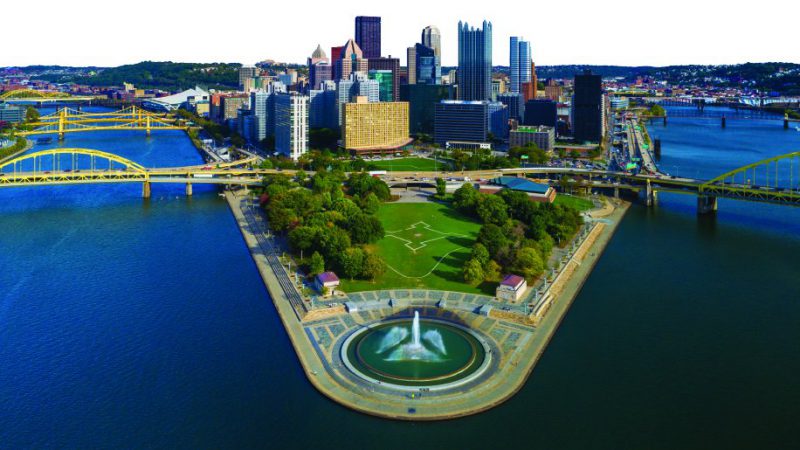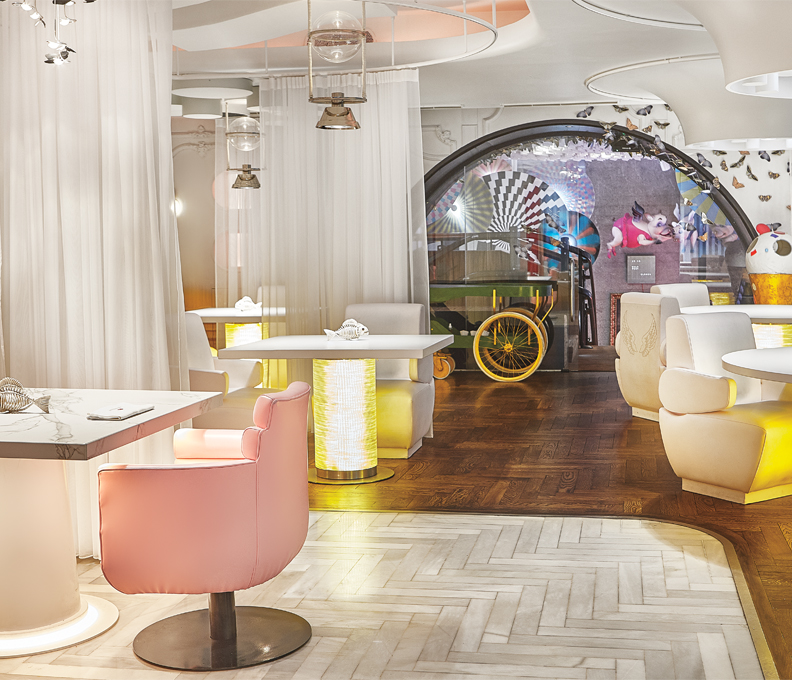Built To Last
Long known for its heavy industry, Pittsburgh has reinvented itself as a thriving tech hub
June 1, 2019

Pittsburgh deserves its moniker of the Steel City, even now that the steel works have moved away. First, there are the 446 bridges, many made of the same material, that span its three rivers – the Allegheny, the Monongahela and the Ohio. Then there is the Steel Building – at 64 stories, one of the tallest in the city, and displaying its dark steel exterior as a badge of pride. Even its NFL team, the Pittsburgh Steelers, is named after the city’s best-known export.
More than any of these, there’s the character of the people – friendly, welcoming and yet pragmatic, no-nonsense, and with a touch of toughness; a bit of steel, you might say, coming from the shared heritage of this industrial city. This was a tough, hard-working place, and you get the sense that no one wants toforget that history forged with grit. Why should they, when it has left such a legacy?
For Pittsburgh is the city that made America. Its steel went into rails that opened up the continent, and provided the skeleton frames for the skyscrapers that came to define its cities. As that industry moved abroad, Pittsburgh suffered, although not as badly as many other places, and today it has been reborn as a high-tech center, meaning visitors see regeneration rather than decay.
Proud Past
Walk around downtown and you quickly find yourself examining brick and stone-cast frontages of 19th-century commercial and office buildings, many now converted into apartments. Grand civic buildings slow your step, while the huge theatres dating from a century ago – and refurbished many times since then – still welcome audiences.
Historic buildings have also been renovated by several hotel companies – the Distrikt Hotel (distrikthotelpittsburgh.com), for example, part of Hilton’s Curio Collection, is an impressive reimagining of an old Salvation Army hostel, with the restaurant in the former gym. There is no sense of faded grandeur to Pittsburgh; the city celebrates the past, but very much looks forward.
Room to Grow
The airport is a good symbol of this push to the future. At its peak, in the 1990s, Pittsburgh International served 100-plus destinations with more than 600 flights per day and 20.5 million passengers annually. At its lowest, in 2013-14, this fell to 37 destinations and 7.8 million passengers – a decline that was completely out of the hands of the airport and the city. US Airways, which had one of its hubs here, moved away. The effect was instantaneous.
“When the hub left, the airport was in pretty big trouble,” says airport chief executive Christina Cassotis. She points out that Pittsburgh wasn’t alone. “The entire Midwest lost its hubs: Cleveland, Cincinnati, Minneapolis, St Louis, Memphis, Nashville. It’s just that Pittsburgh was the first to go.”
When she joined in 2015, Cassotis was clear that the airport’s future was in point-to-point traffic, and in that it is succeeding. Of those 21 million passengers back in the nineties, 15 million were on connecting flights, so the 9.7 million point-to-point travelers of today represent an increase.
In April the city welcomed the return of British Airways, which is operating a four-times weekly service from London Heathrow. The smiles weren’t just because of the route’s commercial importance. BA’s return was viewed as a vote of confidence in a city that has seen many ups and downs, but for the past decade has most definitely been on the upswing.
The airport is also building for the future, breaking ground on a $1.1 billion terminal designed by Luis Vidal (responsible for Heathrow’s Terminal 2), which will open in 2023.
There is certainly room for more growth. “We have over 13 square miles of land,” Cassotis says, “making us the seventh-largest airport in the US, and we have four working, maintained runways.”
The airport is building a 195-acre “Innovation Campus” inspired by Amsterdam Schiphol, featuring office and industrial space plus a “town center” that will be home to restaurants and shops. The discovery of deposits of shale gas on airport property has led to a plan to develop a micro-grid to generate power. The resulting stream of revenue will subsidize airport operations and lower costs, which will in turn attract more airlines to increase the number of flights.
“We also have the advantage of the whole airport being a foreign trade zone, meaning companies can manufacture and assemble without paying duty if they ship out,” Cassotis explains. “Everything we can do to lower the cost of someone moving there will be an incentive.”
Business Friendly
This practical focus on providing companies with what they need to stay in the city or set up here is emphasized by its elected officials. “Pittsburgh, probably of any US city, has the most to offer for the cost of doing business,” says Rich Fitzgerald of the Allegheny County Executive. “If you go to San Francisco or Boston, you’re paying $800,000 to $1 million for a house and a lot for square footage for commercial premises. In Pittsburgh, that house is $200,000, so [the likes of] Google can afford to attract talented people into their operation at a competitive price. That’s why we’ve got so many companies wanting to have operations here.”
Of the companies that have remained in the city, Pittsburgh Plate Glass is one of the best known. Founded in 1883 and headquartered in an unmistakable building that looks like a cathedral made of glass, it is now one of the world’s leading manufacturers of paint, coatings and special materials, manufacturing several products for the 787 Dreamliner, including its electrochromic windows.
“Pittsburgh is our historic home,” says Arthur Pang, in charge of government affairs for the company. “We’ve never left, but the reason we are still here is because the city has a great workforce thanks to Carnegie Mellon University and the University of Pittsburgh.”
It also has little problem attracting workers to the city. “I’m an example of that,” Pang says. “I moved from New York City several years ago, and in my mind there’s no doubt that Pittsburgh has a higher standard of living and a much lower cost.” Pang also points out that the city has “a regional proximity to lots of places” and that the transport connections beyond the airport are excellent.
Another long-time company here is ATI (Allegheny Technologies Incorporated. “We have been incorporated in Pittsburgh for more than 100 years,” says senior vice-president and chief commercial and marketing officer Kevin B Kramer. “We were originally a steel company and now supply the titanium for the 787 and the nickel super-alloys for the General Electric GEnx engines.”
Tech Hub
Then there are the companies moving to the city, or starting up here. The Strip District northeast of downtown is a good place to get a sense of this. The name comes from its geography; this strip of land bordered by high bluffs was a place of heavy industry throughout the 1900s. In 1927 HL Mencken described it as “a scene so dreadfully hideous, so intolerably bleak and forlorn that it reduced the whole aspiration of man to a depressing joke.” Pittsburgh was “hell with the lid taken off.”
Eventually, the blast furnaces moved away, to be replaced by mills and warehouses. And now, after experiencing a period of decline, the technology companies are taking over the former warehouses.
Uber, for example, has based its Advanced Technologies Group here. Walk around and you might see one of the company’s autonomous vehicles being tested out, easily spotted by the LiDAR (light detection and ranging) technology on their roofs. I was tempted to run out in front of one of them to see if it stopped, but although they are driverless, there’s always someone inside, perhaps not with their hands on the steering wheel but monitoring the car’s performance.
Uber isn’t the only big name in the district. Last month the Pittsburgh Post-Gazette reported Fortune 100 company Honeywell was taking 25,000 square feet of space, joining Apple, Argo AI, Bombardier and Facebook. Not all of these organizations advertise their presence with logos on the front of their buildings, but I was told several times that “everyone knows they are here.”
Designed for Life
As younger people have moved to the city, they bring with them expectations of the sort of amenities they want to find nearby, whether that’s coffee shops or bike lanes or good restaurants. This has meant that Pittsburgh was recently voted the second most liveable city in the US in the Economist Intelligence Unit’s Global Liveability Index (Honolulu was first).
The Allegheny Conference on Community Development was set up by the city’s leaders during the World War II to solve such problems as air pollution for business and the city. “We are a 75-year-old civic leadership organization that focuses on ensuring the Pittsburgh region is a great place to do business and to live,” explains Stefani Pashman chief executive. “So we spend a lot of time investing in civic problem solving. We focus on attracting businesses to the region and we are the front door for them, but we also have the Chamber of Commerce under our auspices.”
Pashman emphasizes the continuity in what Pittsburgh offers. “We sell ourselves on the knowledge economy, but we also make things so we have a robust manufacturing and energy history.”
You can learn more about the history of Pittsburgh and its illustrious companies in the superb seven-story Senator John Heinz History Center in the Strip, recognizable by the neon Heinz Ketchup bottle sign on its exterior. Its exhibits tell the stories of the famous industrialists who helped to build the city and then donated much of the money they made for future civic projects – Andrew Carnegie, Henry Clay Frick and the Mellon family. It is one of several world-class museums in the city, including the Carnegie Museums of Art and Natural History, and the Carnegie Science Center, as well as the outstanding Andy Warhol Museum.
For most of the year there will also be sports. The Pittsburgh Steelers are the best known of the city’s teams, but there’s also the ice-hockey squad, the Pittsburgh Penguins, and baseball with the Pittsburgh Pirates. The last of these plays at PNC Park, which offers superb views of the Roberto Clemente bridge and the Downtown skyline.
The city’s food offering ranges from traditional dishes that kept manual employees going through their punishing workdays to cuisine that is the match of any major US city. Union Standard, for instance, has a daily selection of oysters, clams and scallops as well as wood-grilled steaks – perfect washed down with a local beer such as Penn Pilsner – and makes a big play on the provenance of its produce. It is located in the beautiful Union Trust Building, erected by Frick in 1915 as a shopping arcade and featuring a huge rotunda in its center; it’s next to the sophisticated Omni William Penn hotel.
Down on the Strip, you’ll find many third- and fourth-generation establishments serving everything from authentic Italian cured meats to Greek specialties, and the much-loved Stamoolis Brothers supermarket. Then there are the famous Sunseri sandwiches, more than a foot long, and the Primantis chain of restaurants (also known for its sandwiches), which includes a new branch that has opened airside at the airport.
For visitors, one of the joys of Pittsburgh is its rich cultural scene. “From our old industrial days, we have a great symphony, ballet, theater museum, sports teams and all of the things that a big city has, but at a much lower price,” Fitzgerald says.Pittsburgh may be marketing itself as a gateway city to Pennsylvania, but to those visiting, the real challenge will be in leaving a city that has so many places to visit and so much to offer. visitpittsburgh.com




